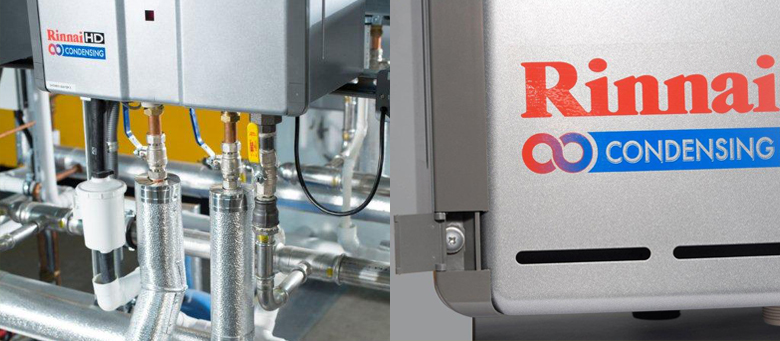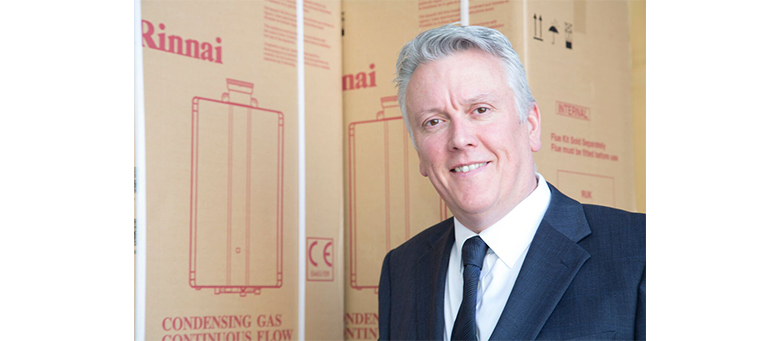According to Chris Goggin – associate director of Rinnai UK – renewables technology paired with a continuous flow hot water heating unit can affect major efficiencies in domestic hot water provision.
We need to find ways of using current renewables technology, be it solar thermal, solar PV or heat pump technology, in a practical manner maximised by traditional fuel sources. One of the most ecological and economical methods is to design a system with primary renewable sources and supported by secondary sources such as continuous flow hot water heating.
There has been pioneering products in this category – this includes solar thermal store of hot water and both flat plate and evacuated tube collectors, each with specific benefits to suit the differing design aspects and building envelope needs. Either option will provide years of low-maintenance, low-cost energy for heating water during the summer months – and beyond.
Water heated by the solar panels is stored and technologically this is unlikely to come up to a workable temperature all year round, so the boosting of the pre-heated water to the required temperature by a secondary heat source will be a requirement. With this system it will guarantee maximum solar gain whilst optimizing gas input.
In this scenario a continuous flow water heater can be utilised as the secondary heat source to give the solar heated water the required boost.
These are hot water heating products which are intelligent, fully modulating units, giving an output range from 56kW down to 2.27kW, and only use as much gas as is needed to bring the required volume of water to temperature. For example, if the solar panel array can only achieve a temperature of 40°C within the stored water instead of the required 60°C, and there is a demand on the system of 15 litres a minute, the fully modulating intelligent Rinnai unit will increase the temperature by the required 20°C (±1°C) whilst only using the required 21kW. If the demand drops to say 5l/min the heater will modulate down accordingly to an output 7kW.
As can be seen a Rinnai unit used as a gas booster for solar systems will not only maximize solar gain, it will only use the correct amount of energy for the particular demand at the time. The rest of the time the unit is inactive. It is this, the booster, that ensures never-ending hot water – no matter the demand so people can shower or bath any time of the day or night or whatever the weather conditions. Fossil fuel is only used when the renewable thermal energy store is below its set-point, thus reducing the dependency on fossil fuel and reducing CO2 emissions.
This system is a blueprint for maximizing renewables gain. If you want to make it even more so, opt for one of Rinnai’s condensing water heaters and push the efficiencies envelope even further.
Another technological advantage in using a continuous flow water heat as a booster is that you can wipe out any worries about legionella being a problem with stored water.
If the store is below 60°C the Rinnai Continuous Flow Water heater always ensures that the 60°C minimum is always met, so the system will always comply with Building Regulation L8. If a secondary return system is used again there is a guarantee that the return will always be at 50° again in compliance of L8.
For all-year round domestic hot water, Rinnai Infinity HE gas fired condensing continuous flow water heaters are supplied renewables-ready and are also easily retrofitable with current renewable technology.
Both flat plate and evacuated tubes collectors work best when facing due south. However, evacuated tube collectors will outperform their flat plate counterparts in situations where only east/west facing options are available.
Evacuated tube collectors have multiple glass tubes that heat up by absorbing the sun’s energy. The vacuum insulated tube retains most of this heat and the constant profile of the round tube means that the collector is always perpendicular to the sun’s rays. The energy absorbed is therefore approximately constant over the course of the day.
In the summer months, the flat plate option will be close to that of an evacuated tube unit when facing south. However, evacuated tube collectors have better overall results in both the early and late seasons and are not affected by adverse weather conditions, producing impressive temperatures even on cloudy days. However, flat plate collectors are perhaps more suited to vulnerable locations because of their exceptionally sturdy and durable build.
Rinnai’s award-winning renewable water heating solutions are designed to offer a perfect blend of eco-friendly technologies, guaranteed to provide a constant flow of hot water 365 days of the year. The pairing of a Rinnai Infinity unit with renewables technology really is the perfect fit for a never ending DHW supply.
Rinnai’s expert team is available to help with the design, specification and installation of a renewables heating system.
For more information on the RINNAI product range visit www.rinnaiuk.com.














